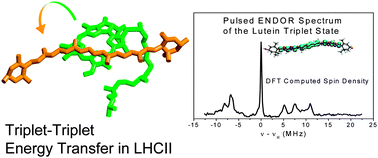The electronic structure of the lutein triplet state in plant light-harvesting complex II†
Abstract
Carotenoid molecules are essential for the life of photosynthetic organisms in that they protect the cell from the photo-oxidative damage induced by light-stress conditions. One of the photo-protective mechanisms involves triplet–triplet energy transfer from the chlorophyll molecules to the carotenoids: a process that is strongly dependent on the electronic properties of the triplet states involved. Here, we obtain a clear description of the triplet state of lutein in LHCII from higher plants for the first time by density functional theory (DFT) calculations. DFT predictions have been validated by comparison with hyperfine couplings obtained with pulsed-ENDOR spectroscopy. Knowledge of the spin density distribution, the frontier orbitals and orbital excitations forms a basis for discussing the requirements for an efficient triplet–triplet energy transfer. The results obtained for the lutein in LHCII are compared with those of the highly-substituted carotenoid peridinin in PCP from Amphidinium carterae [Di Valentin et al., Biochim. Biophys. Acta, 2008, 1777, 295–307]. The presence of substituents in the peridinin molecule does not alter significantly the triplet state electronic structure compared to lutein. Despite the unusual spectroscopic behaviour of the peridinin excited singlet state, lutein and peridinin have similar triplet state properties. In both molecules the unpaired spins are delocalized uniformly over the whole π-conjugated system in an alternating even–odd pattern.


 Please wait while we load your content...
Please wait while we load your content...